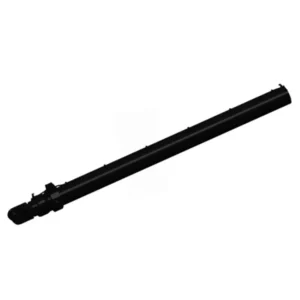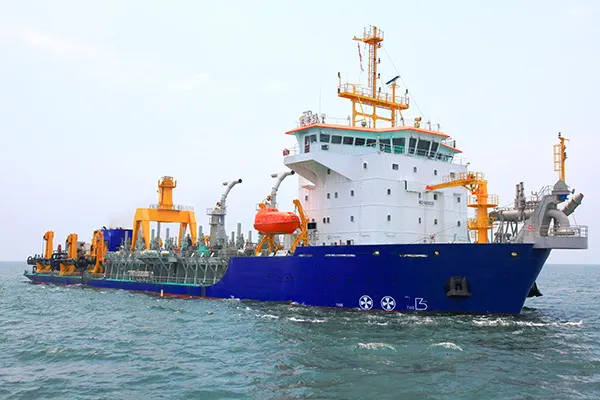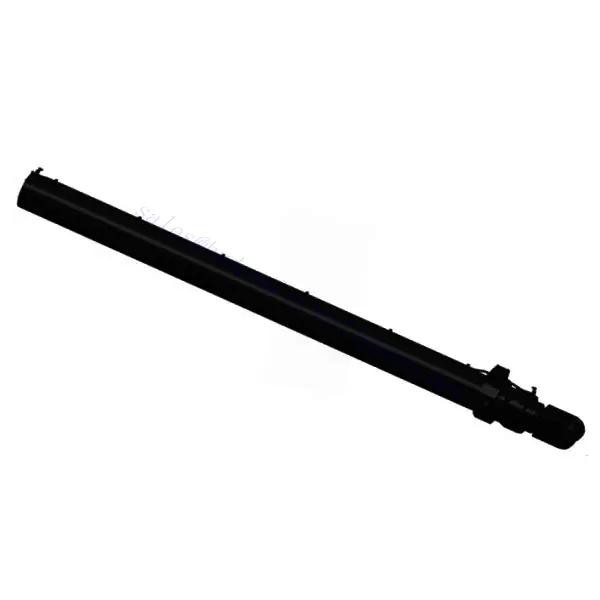Cutter Suction Dredger Inverted Pile Cylinder
Üheks hüdrosilindrite tootjaks, tarnijaks ja mehaaniliste toodete eksportijaks pakume hüdrosilindreid ja paljusid teisi tooteid.
Palun võtke meiega ühendust üksikasjade saamiseks.
Post:sales@hydraulic-cylinders.net
Tootja tarnija eksportija hüdrosilindrid.
Cutter Suction Dredger Inverted Pile Cylinder

The cutter suction dredger inverted pile cylinder is a groundbreaking hydraulic device transforming marine construction projects. With its innovative design and exceptional performance, this cylinder is crucial to modern dredging operations.
The cutter suction dredger inverted pile cylinder has revolutionized marine construction by offering exceptional performance in piling operations. Its inverted design, high-pressure capacity, and corrosion resistance make it a reliable and durable hydraulic device. By following proper usage methods and carrying out regular maintenance, marine construction professionals can maximize the efficiency and accuracy of their projects. Embrace the power of the cutter suction dredger inverted pile cylinder and experience the difference it can make in your marine construction endeavors.
Cutter Suction Dredger Inverted Pile Cylinder Key Characteristics:
- Inverted Design: The cutter suction dredger inverted pile cylinder boasts a unique inverted configuration, with the piston rod extending downward from the cylinder. This design allows for efficient and precise piling operations in marine environments.
- High-Pressure Capacity: This cylinder is engineered to withstand high-pressure conditions, ensuring reliable and robust performance even in challenging marine construction projects. It delivers the power and force necessary for driving piles into the seabed with exceptional accuracy.
- Corrosion Resistance: Constructed from high-quality materials, the inverted pile cylinder exhibits excellent resistance to corrosion, rust, and abrasion. This feature enhances its durability, making it suitable for prolonged use in harsh marine conditions.
Cutter Suction Dredger Inverted Pile Cylinder Parameter:
| Product Name | Cutter Suction Dredger Inverted Pile Cylinder |
| Features: | Provide push and pull force for the retracting and unfolding of the steel pile |
| Bore diameter: | Up to 620 mm |
| Rod diameter: | Up to 360 mm Stroke up to 5200 mm |
| Pressure: | up to 32MPa |
| Thrust force: | Maximum 7500KN |
| Pulling force: | Maximum 5000KN |
| Applications: | Cutter Suction Dredger |
Rod diameter: up to 360mm
Stroke up to 5200mm
Dredger Tank Cutter-Suction Cylinders Application:

Usage Method Of Cutter Suction Dredger Inverted Pile Cylinder:
- Preparation: Before using the cutter suction dredger inverted pile cylinder, ensure all safety precautions are in place. Conduct a visual inspection to verify that the cylinder and its components are in good condition, with no signs of damage or leaks.
- Positioning: Position the cylinder in the desired location for piling. Ensure that it is securely attached to the dredger or other equipment, providing stability and support during the operation.
- Connection: Connect the hydraulic hoses or fittings to the appropriate ports on the cylinder and the hydraulic power source. Confirm that the links are secure, leak-free, and properly aligned.
- Adjusting Stroke Length: Adjust the stroke length of the cylinder according to the required piling depth. This can typically be done using the controls or mechanisms provided. Follow the manufacturer’s instructions to ensure precise adjustment.
- Piling Operation: Activate the hydraulic power source to initiate the piling operation. The cutter suction dredger inverted pile cylinder will exert controlled force to drive the piles into the seabed. Monitor the process closely, ensuring the desired depth and accuracy are achieved.
How To Replace Seals On A Hydraulic Cylinder?
Replacing seals on a hydraulic cylinder is a common maintenance task that helps restore its performance and prevent leaks. Here’s a step-by-step guide on how to replace seals on a hydraulic cylinder:
- Safety Precautions:
- Ensure the hydraulic system is depressurized, and the cylinder is fully extended.
- Follow proper lockout/tagout procedures to prevent accidental activation of the system.
- Cylinder Removal:
- Disconnect any hydraulic hoses or fittings connected to the cylinder.
- Remove any retaining pins or bolts securing the cylinder to the equipment.
- Carefully slide or maneuver the cylinder out of its mounting brackets or connections.
- Seal Identification:
- Identify the types and sizes of the seals that need replacement. This information can be found in the cylinder’s documentation or by measuring the old seals.
- Disassembly:
- Place the cylinder on a clean work surface.
- Remove the end cap(s) of the cylinder using appropriate tools, such as wrenches or socket sets.
- Carefully remove the piston, rod, and old seals from the cylinder barrel.
- Take note of the order and orientation of the components as you disassemble them.
- Seal Removal:
- Gently remove the old seals from their respective grooves using seal removal tools or picks.
- Be careful not to damage the cylinder bore or other surfaces during this process.
- Cleaning and Inspection:
- Clean the cylinder barrel, piston, rod, and other components using a suitable cleaning solvent to remove dirt, debris, and hydraulic fluid residue.
- Inspect all parts for signs of damage or wear, such as scoring, pitting, or cracks.
- Replace any damaged or worn components as necessary.
- New Seal Installation:
- Lubricate the new seals with hydraulic oil before installing them.
- Carefully insert the new seals into their respective grooves, ensuring they are properly seated.
- Use seal installation tools or suitable improvised methods to press the seals evenly into place.
- Be cautious not to damage the seals during the installation process.
- Kokkupanek:
- Install the piston, rod, and seals back into the cylinder barrel, following the correct order and orientation.
- Apply a thin layer of hydraulic oil to the seals and other contact surfaces.
- Carefully reattach the end cap(s) and tighten them securely to the manufacturer’s specifications.
- Ensure all threaded connections are properly aligned and tightened.
- Cylinder Reinstallation:
- Slide or maneuver the reassembled cylinder back into its mounting brackets or connections.
- Reattach any retaining pins or bolts to secure the cylinder in place.
- Reconnect the hydraulic hoses or fittings to the cylinder, ensuring proper alignment and tightness.
- Testing and Inspection:
- Re-pressurize the hydraulic system and check for any leaks or abnormal operation.
- Fully extend and retract the cylinder to ensure smooth movement and proper functioning.
- Inspect the cylinder and its connections for any signs of leakage or other issues.
Tehase võimekus ja suutlikkus:
(1) Kokkupanek
Meil on esmaklassiline sõltumatu teadus- ja arendustegevuse montaažiplatvorm. Hüdrosilindrite tootmistöökojas on neli poolautomaatset tõstesilindrite koosteliini ja üks automaatne kallutussilindrite koosteliin, mille kavandatud aastane tootmisvõimsus on 1 miljon tükki. Spetsiaalsete silindrite töökoda on varustatud erinevate spetsifikatsioonidega poolautomaatse puhastusmontaažisüsteemiga, mille kavandatud aastane tootmisvõimsus on 200 000 ja mis on varustatud kuulsate CNC-töötlemisseadmete, mehaanilise töötlemise keskuse, suure täpsusega silindrite töötlemise eriseadmete, robotkeevitusmasina, automaatse puhastusmasina, automaatse silindri kokkupanemise masina ja automaatse värvimise tootmisliiniga. Olemasolevad kriitilised seadmed rohkem kui 300 komplekti (komplekti). Seadmete ressursside optimaalne jaotamine ja tõhus kasutamine tagavad toodete täpsusnõuded ja vastavad toodete kvaliteedinõuetele.


(2) Töötlemine
Töödeldav töökoda on varustatud kohandatud kallutatud rööpse treipingi keskuse, mehaanilise keskuse, kiire lihvimismasina, keevitusroboti ja muude seotud seadmetega, mis suudavad töödelda silindritorusid, mille maksimaalne siseläbimõõt on 400 mm ja maksimaalne pikkus on 6 meetrit.

(3) Keevitamine

(4) Värvimine ja katmine
Väikese ja keskmise suurusega silindri automaatse veepõhise värvipinnakattega liinide abil, et saavutada automaatne robotlaadimine ja mahalaadimine ning automaatne pihustamine, projekteerimisvõimsus 4000 tükki vahetuse kohta;
Meil on ka poolautomaatne suurte balloonide värvimise tootmisliin, mis töötab jõukettaga ja mille projekteerimisvõimsus on 60 kasti ühe vahetuse kohta.


(5) Testimine
Meil on esmaklassilised kontrolliseadmed ja katsestendid, et tagada silindri jõudlus vastavus nõuetele.

We are one of the best hydraulic cylinder manufacturers. We can offer comprehensive hydraulic cylinders. We also provide corresponding põllumajanduslikud käigukastid. Oleme eksportinud oma tooteid klientidele üle maailma ja teeninud hea maine tänu meie suurepärasele tootekvaliteedile ja müügijärgsele teenindusele. Me tervitame kliente kodus ja välismaal, et võtta meiega ühendust, et pidada läbirääkimisi äri, vahetada teavet ja teha meiega koostööd!
Tehke ekskursioon meie VR-tehases:
Tehke ekskursioon meie VR-tehases koos järgmisega
Kuidas töötab kahveltõstuki hüdrosilinder?
Hüdrosilindri kasutamine:


